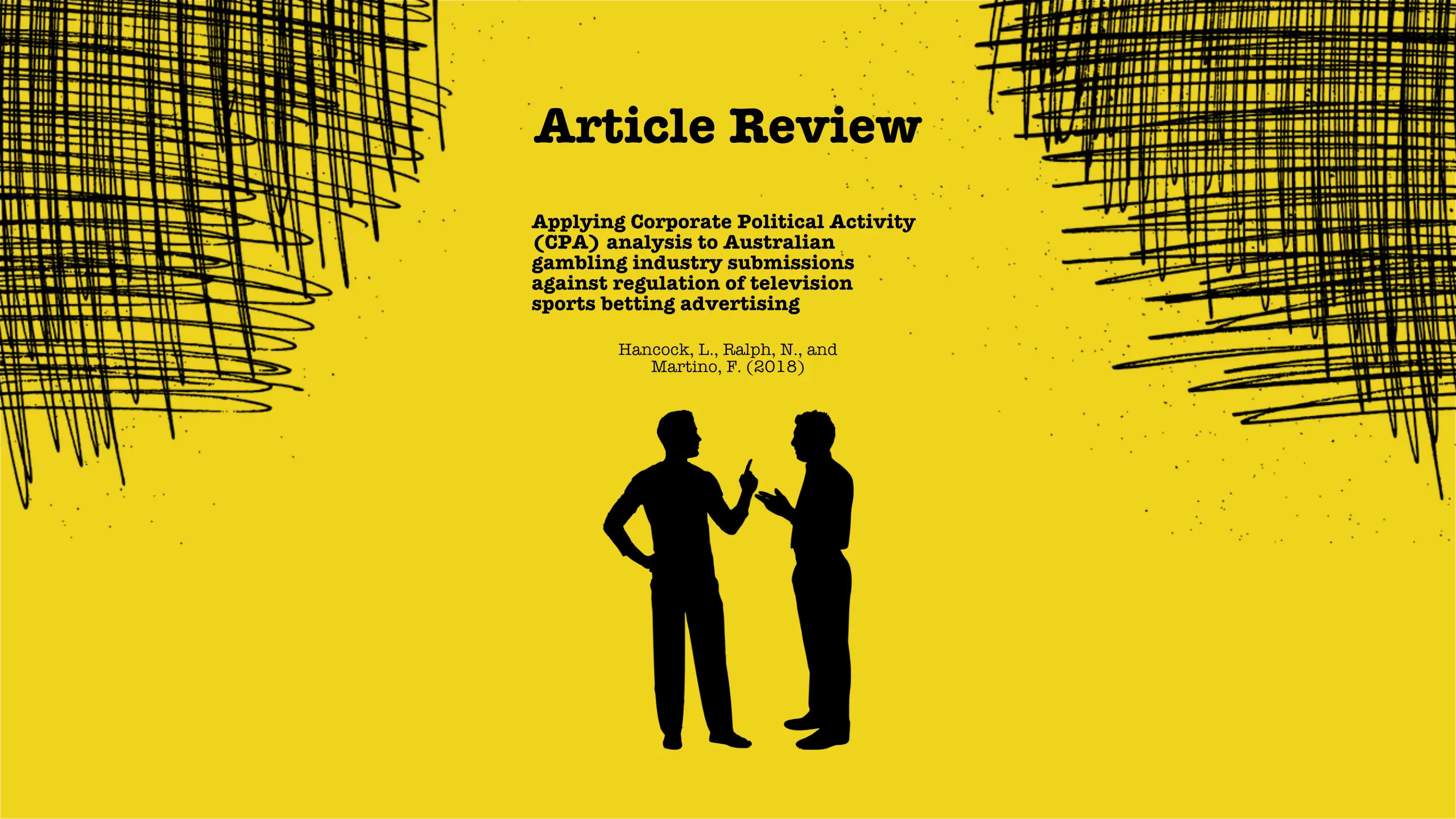The gambling industry has evolved into a powerful lobbying force, employing sophisticated corporate political activity (CPA) strategies to influence policymaking and public discourse.
In Applying Corporate Political Activity (CPA) Analysis to Australian Gambling Industry Submissions Against Regulation of Television Sports Betting Advertising (Hancock, Ralph & Martino, 2018), the authors dissect the ways gambling providers seek to protect their commercial interests while maintaining a public image of responsibility and social contribution.
Much like the tobacco and alcohol industries before it, gambling’s corporate strategy hinges on framing, deflection, and selective evidence use — positioning itself as a responsible partner in regulation rather than a target of reform.
Key Concepts
1. Lessons from the tobacco and alcohol industries
The gambling sector has drawn directly from tobacco industry playbooks, adopting similar lobbying methods to resist or dilute regulation.
Historically, tobacco companies used six core strategies:
- Information strategy
- Financial incentive strategy
- Constituency building strategy
- Policy substitution strategy
- Legal strategy
- Constituency fragmentation and destabilization strategy
Gambling operators have replicated these methods, adapting them to a digital context and incorporating Corporate Social Responsibility (CSR) narratives as a seventh, industry-specific tool.
2. The informational strategy
The informational strategy focuses on shaping — and often distorting — the evidence base to favor private interests.
For instance, operators claim that stronger gambling restrictions would drive players toward illegal or offshore markets, a classic negative unintended consequences argument.
This selective communication normalizes gambling, emphasizing its entertainment value while downplaying associated harms such as addiction, financial loss, and social damage.
As Hancock et al. note, the gambling industry enjoys information asymmetry over governments and communities, having access to internal research and proprietary data unavailable to policymakers.
3. The financial incentive strategy
The financial incentive strategy underscores the industry’s economic contribution — employment, taxation, and community sponsorships — to dissuade governments from introducing restrictive policies.
This strategy frames gambling as a public good, rather than a regulated vice.
In Australia alone, gambling companies declared over A$1.29 million in political donations in 2015–16 — an amount likely underestimated — while also highlighting gambling tax revenues as “a lucrative on-going source of State/Territory government income.”
Such economic framing gives the industry leverage in political negotiations, creating dependency relationships between regulators and operators.
4. Policy substitution and CSR framing
When regulation seems inevitable, gambling operators often pivot to policy substitution — promoting “responsible gambling” campaigns as evidence of proactive self-regulation.
CSR initiatives allow companies to control the narrative by shifting focus from systemic harm to individual responsibility.
As Hancock et al. observe:
“Responsible gambling was framed in terms of the individual's responsibility to avoid harm and to act responsibly ... reinforcing an individual choice/blame model for problem gambling, rather than a consumer protection perspective.”
This approach diverts attention from the need for stricter advertising and access controls, instead emphasizing voluntary tools and education programs.
5. Constituency fragmentation and destabilization
Another tactic involves dividing potential opposition — creating conflicts of interest among stakeholder groups.
For example, land-based oligopolies may align temporarily with regulators to limit the growth of online competitors.
This fragmentation weakens unified reform movements, allowing the industry to maintain its influence through carefully managed alliances.
6. Sponsorships and public goodwill
Sports sponsorships, charity partnerships, and community funding projects form part of the constituency-building strategy, where gambling companies seek public approval through visible contributions to sports and culture.
These efforts divert attention from regulatory criticism and help preserve advertising privileges, particularly within televised sports.
The positive social image generated through sponsorships complements CSR narratives, reinforcing the perception of gambling providers as socially responsible actors rather than aggressive commercial entities.
7. The danger of co-regulation
Perhaps the most concerning outcome of these tactics is the rise of co-regulation models, where gambling providers are treated as “partners” in policy development rather than subjects of oversight.
While collaboration can improve compliance, it risks compromising regulatory independence and enabling industry capture.
Policymakers must remain aware that gambling companies are motivated, well-resourced lobbyists, with both the means and incentive to steer public policy in their favor.
8. Striking a fair balance
The ultimate challenge lies in achieving equilibrium — ensuring community well-being and consumer protection without creating conditions that encourage illegal gambling markets.
As the authors conclude, regulation should aim to balance “the wellbeing of the community, the regulatory burden, and financial implications imposed on industry.”
Effective oversight, therefore, requires transparency, political integrity, and evidence-based decision-making, shielded from industry distortion.
Selected Citations
- “Tobacco industry operators previously utilized six strategies: information, financial incentive, constituency building, policy substitution, legal, and constituency fragmentation and destabilization.”
- “Responsible gambling was framed in terms of the individual's responsibility to avoid harm … reinforcing an individual choice/blame model rather than a consumer protection perspective.”
- “Gambling industry declaring A$1,294,501 in donations (an underestimate) to Australian political parties in 2015–16.”
- “In public policy deliberations, information asymmetry exists between the gambling industry, government, and community.”
- “The aim of policymakers should be at reaching a fair balance between the wellbeing of the community, the regulatory burden, and financial implications imposed on industry.”
Academic Reference
Hancock, L., Ralph, N., & Martino, F. (2018). Applying Corporate Political Activity (CPA) Analysis to Australian Gambling Industry Submissions Against Regulation of Television Sports Betting Advertising. PLOS ONE, 13(10).
External References
No additional references cited beyond the primary academic source.
